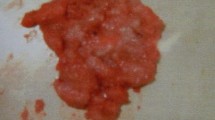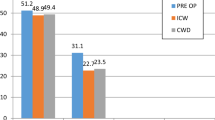Abstract
A chronic discharging ear has been a perpetual problem and a source of worry to the otologists for centuries because of its high rate of morbidity. Active squamous chronic otitis media is a commonly encountered disease entity which requires prompt surgical management. The surgical procedure most commonly employed is modified radical mastoidectomy. This results in an ‘open’ cavity with its attendant problems of recurrent breakdown and discharge. Mastoid obliteration technique would appear to be the best solution for these cavity problems. Forty cases of active squamous chronic otitis media were studied. The patients were randomly divided into two groups of 20 each. The group of 20 controls had an open mastoid cavity. Out of the 20 cases, patients were divided in four groups of 5 each. For each group the mastoid cavity was obliterated with cartilage, bone dust, hydroxyapetite and Singapore swing. Healing of the cavity and the associated cavity problems in terms of pain, discharge, giddiness and wax formation, were assessed. The incidence of pain, discharge, giddiness and wax formation was markedly reduced in obliterated cavities as compared to open cavities. Healing of the cavity as evidenced by epithelialisation, at the end of 6 months, was better in those ears where cavity was obliterated (90%) as compared to those with open cavity (70%). Cases obliterated with bone dust and Singapore swing had better and early epithelialisation (100%) as compared to cartilage and hydroxyapetite (80%).







Similar content being viewed by others
References
Moffat DA, Gray RE, Irving RM (1994) Mastoid obliteration using bone pate. Clin Otolaryngol 19:194–198
Plester D, Steinbach E (1977) Histological fate of tympanic membrane and ossicle homograft. Otolaryngol Clin N Am 10(3):487–499
Grote JJ, Van Butterswrik CA (1986) Reconstruction of posterior canal wall with hydroxypetite prosthesis. Ann Otorhinolaryngol 95(supp 123):10–12
Gibb AG, Tan KK, Sim RST (1997) The Singapore swing. J Laryngol Otol 111:527–530
Sade J, Weinberg J, Berco E, Brown M, Halvey A (1982) The marsupialised (radical) mastoid. J Laryngol Otol 96:869–875
Wadhwa V, Anand TS (2003) Periosteo temporofascial flap for cavity obliteration—1st Indian study. Indian J Otolaryngol Head Neck Surg 55(3):170–174
Author information
Authors and Affiliations
Corresponding author
Rights and permissions
About this article
Cite this article
Chhapola, S., Matta, I. Mastoid Obliteration Versus Open Cavity: A Comparative Study. Indian J Otolaryngol Head Neck Surg 66 (Suppl 1), 207–213 (2014). https://doi.org/10.1007/s12070-011-0429-x
Received:
Accepted:
Published:
Issue Date:
DOI: https://doi.org/10.1007/s12070-011-0429-x




